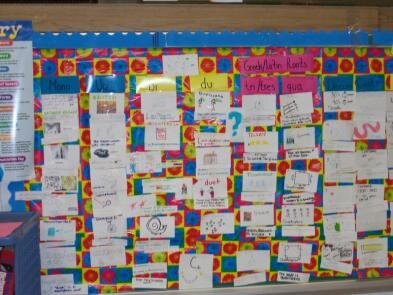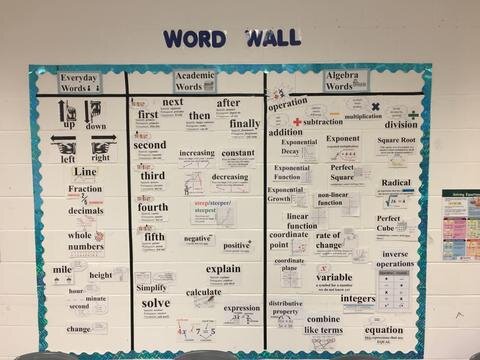Pictures of Middle School Word Walls
If Word Walls Could Talk, They Would Ask For More Student Interaction
By Sarah Said
Oh, the lovely word wall. It's the beginning of the year and you are getting your classroom into shape. This was always one of my favorite times of the year as a teacher. You unpack your laminated cards for your word wall. All of your different types of site words are color coded. You also have categories of content words your kiddos will learn during the year. You hang them up, just as you had seen them in the picture on Pinterest the year before. Lovely! They are nice and neat. They make your room look so pretty! Yes… pretty. But have you asked yourself, how often do your students interact with the wall? What is the purpose of the wall? Is it because you need to have a word wall and this looks nice up there? Is your classroom really engaged with it? These are some questions we need to ask ourselves as we are trying to create a language experience for our students.
Before we even continue to jump into how students can interact with word walls, we need to think about how we assemble our word walls. Months ago, I gave a professional development on word walls to a group of teachers. This is the picture that I showed them:

One of them yelled out "Ugh, that is so messy!" Yes, it is. I took this picture years ago when I taught high school ELL English Language Arts. Back then, I and Phone were not fused together to form a word so the quality of the picture is not all that. Also, I was a newer teacher and pretty broke so instead of buying bulletin board paper, I used a funky wrapping paper design that I found at the local Dollar Tree. I don't know what was up with style and taste in my early 20's! But, if you look at the word wall closely, you will see that the word cards are not really the neatest, but they are pretty authentic. My students created those word cards with me. They also provided visuals and sentence examples.
Yes, my setup may not have won the Pinterest "Word Wall of the Year" award. Let's just face it, it was a tacky hot mess. However, my students interacted with the wall by having a vocabulary scrapbook that listed the words on the wall with pictures or symbols that created a memory cue for students. They reviewed sections of words with me daily. We also had our own assessments we created together as a class with picture cues. (Microsoft Office had pretty funky clip art back in those days.) At the end of the year, I worked with the class to fuse those assessments together into a final exam. Not to toot my own horn, but back in my day we didn't succumb to Teachers Pay Teachers to find vocabulary resources. But this good old fashioned way of working with my students to learn vocabulary (We studied different types of syllables, affixes, roots and derivatives in my ELL Language Arts Class.) was very reliant on a student generated and interactive word wall.
Knowing and Communicating The Purpose of Your Word Wall
Why is this important? Direct instruction of vocabulary and constant practice with vocabulary supports clarity for English Learners across content areas. It is not slowing down instruction, it is appropriate differentiation needed for our students. "Teaching ELs vocabulary the same ways you teach non-ELs vocabulary may not be effective, so you will need to try out and adopt new strategies that are effective with ELs in your classroom." (Snyder & Staehr Fenner, 2017) The value of isolating vocabulary instruction for English Learners is endless. The word wall is a critical piece of it. Because of this, it is only fair to really put the time and energy in making your word wall useful to students and connect your word wall to your vocabulary instruction. Think of it this way, if you had to learn Science as an English only speaker in Mandarin Chinese, wouldn't you want your teacher to create a word wall that is useful to you with visuals and print you can see and understand?
Understanding the purpose of your word wall is one thing. The students knowing the purpose of the word wall is another. Clearly communicating the purpose of the word wall to students will increase their engagement with it. When students understand the "why" behind having a word wall and your routine of interaction with it, it becomes more meaningful and powerful to them. Before you can even explain your word wall routine, you need find ways of helping students know how the word wall connects to their understanding of content. There are a couple of different ways you can do this. First, you can explicitly tell them why you are using the word wall routine. Afterwards, you can use your content and language objectives to emphasize key vocabulary that will be part of the word wall. I like to underline the words and then break them down after I introduce objectives. Then you need to consistently explain and model your word wall routine for your students. It's important to do this because the vocabulary instruction and word walls are not about what the teacher likes. It's more about what is best for kids.
The Assembly of A Student Generated Word Wall
Having your students generate your word wall is probably the best thing you can do for them. I have done this as a teacher at the Middle School and High School Level. What I have done is I have assigned students to document the target vocabulary words in their journals, scrapbooks or personal word wall (This could have been a smaller Science Fair type board). First, I directly teach the words through comprehensible input strategies to the class. Afterwards, all students need to write down each word, a definition in their own words, a sentence, and picture cues. I usually have a pre made table for them. This can then go into a journal or scrapbook. I would use a handout with a table like this to support them:

Then, I have had students choose a word they like or in other cases pick a word out of a hat. The students would then have to create cards that had their picture for the word on it and a sentence (I give out sentence starters for support.) using the word. I would place the most comprehensible cards on the wall. I did make sure that everyone got a turn to have their cards on the wall.
Here are a couple of other examples of ways to assemble a word wall:
There are other teachers like Amy Ebeidalla(twitter handle @FJH_EL) an English Learning English Language Arts Teacher at Finley Junior High School in Chicago Ridge, Illinois who chose to use a four square structure. Students generate cards with key vocabulary, pictures, definitions, and sentences based on vocabulary that the class finds in context of short story mentor texts.

Teacher Snaa Mohammad a Bilingual PreK-5th grade teacher at Ridge Lawn Elementary School in Chicago Ridge, Illinois uses her word wall space to create an interactive bilingual bridge for students. These word walls are interactive, and they allow students to think about the concepts in the native language while learning them in the target language. Snaa is also a teacher who provides clear content and language objectives that support the explicit instruction of content vocabulary. Snaa likes to create anchor charts with her students and hang those on her wall as well. This content engages students in learning and reviewing words for truly understanding them.

Another word wall that I would like to feature in this blog is coming from a K-5 English Learning teacher named Barbara Kulikowski(twitter handle @BKulikowskiEL ) at Ridge Lawn Elementary school in Chicago Ridge, IL. Barbara works with her students to identify key vocabulary. The groups then work with her to create a word wall that is equipped with pictures that help as memory cues.
Following up After the Creation of the Word Wall
Now that you have established a purpose for your word wall, provided your students with direct instruction of vocabulary, and assembled your wall- it's time to think about revisiting the content of it continuously through a lesson. " Students need to be active in developing their understanding of words, engage in techniques that help them to be immersed in learning new words throughout a lesson- not just at the beginning- and develop word learning strategies." (Echievarria, Vogt, & Washam 2015) What we really need to show kids is the variety of strategies to help them build their tool kits, How? We have to have our children's interests, assets, and proficiency levels. From there, we can work with students to develop a variety of vocabulary techniques.
Tips for Engaging with Your Word Wall
Engaging Your Word Wall in Exit Slips: You can simply ask students to write a sentence using the word, identify its part of speech, or draw a picture cue after you have reviewed the content and language objectives at the end of a lesson.
Using Your Word Wall in Songs and Chants: You can follow up with students regarding the words in your lesson by involving the wall in songs and chants you create.
End of the Year Word Collage or Scrapbook: I went through a phase where I was really into scrapbooking. I had students pick ten words they had learned in the unit and create a scrapbook out of them. We used cardstock and copy paper to assemble them. We also used fun duct tape to bind them. For the techies out there, you can use an app called Write Reader. Here, you can digitally create a book and even record it.
Playing and Creating Games With Words in The Word Wall: Having students play and even create their own games on words that are on your word wall gives them reinforcement that is fun. Of course, we all love Kahoot! Using Kahoot to follow up on vocabulary can engage students with words. If you want to be more low tech, using response boards and having competitions with them regarding questions on vocabulary is motivating for some kids in your classroom.
Having students be part of forming a word wall in your classroom is empowering them to take a lead in language learning. Are you going to learn more from something that is handed to you? Or, are you going to learn more through your process of creation? Really, we need to reflect on our practices as teachers of language. How are students really comprehending vocabulary and content? What can we do better? Going back to my first picture in this blog, yeah my word wall was tacky. Maybe my paper choice on the bulletin board could have been better. But, the word wall didn't just belong to me, it belonged to our classroom. As a community of learners, we built it. And, we learned from it.
Check out how ENLACE engages high school students in tiered vocabulary. It's not just about that content vocabulary but also those every day words and phrases that support learning.
Tier 1-every day
Tier 2-general academic
Tier 3-content specific

Pictures of Middle School Word Walls
Source: https://ellstudents.com/blogs/the-confianza-way/if-word-walls-could-talk-they-would-ask-for-more-student-interaction
0 Response to "Pictures of Middle School Word Walls"
Post a Comment